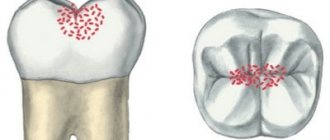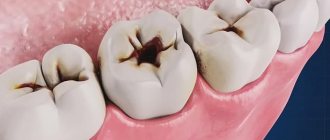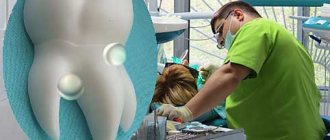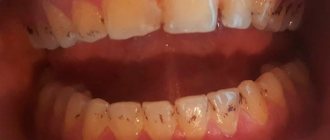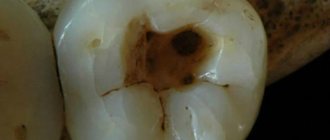Healthy gums are the key to strong teeth and a beautiful smile. Normally, they are pink, cover the alveolar processes and necks of dental units, and are not damaged. Based on their condition, the dentist can judge the health of the oral cavity.
Soft tissues are the first to react to negative changes occurring in the body. Redness of the gums is one of the main signs of inflammation. It can be associated with various factors - from drinking too hot drinks to the development of periodontitis. Find out if it is dangerous and in what cases you need medical help.
Why do stains appear on teeth: the main reasons
The initial form of caries can be provoked by various factors, but most often this happens due to the formation of an acid-base imbalance in the oral cavity. A large number of harmful microorganisms constantly live in the mouth, which actively participate in the process of food decomposition. Food particles tend to remain between the teeth and on their surface, which leads to the destruction of tooth enamel.
Other reasons leading to the destruction of the structure of the enamel layer on the teeth include:
- incomplete or poor oral hygiene. After some time, failure to comply with hygiene rules leads to the appearance of white plaque on the teeth, which acts as an excellent environment for the accumulation of pathogenic bacteria. As a result, microorganisms produce harmful acids, which negatively affects the condition of tooth enamel. This process can be prevented by regular oral hygiene procedures. If, nevertheless, destruction of the enamel is observed, then treatment of caries at the spot stage will help prevent complications;
- hereditary predisposition. Even at the moment of conception and during intrauterine development, the structure and strength of tooth enamel is laid in the baby. When the mother’s body during this period lacks fluoride, calcium, vital vitamins and minerals, the risks that the child’s teeth will be excessively fragile and prone to the formation of carious processes are maximum;
- poor nutrition. Tooth enamel will be hard and durable if the daily diet contains foods high in calcium, fluorine and phosphorus (fish, cheese, cottage cheese, nuts, milk). But foods containing a large amount of carbohydrates (sweets, baked goods) must be kept to a minimum. This will protect the enamel from premature destruction;
- changes in the composition of saliva and its increased viscosity. Along with the fact that saliva is involved in the process of softening the food consumed, it also cleanses the surface of the teeth from food debris. When, due to changes in the structure of saliva, its acidity increases, a constant destructive effect on the teeth is formed. This process leads to the development of carious pathologies.
Often the initial form of caries appears in the area of the neck of the tooth, which is difficult to clean with a toothbrush. Regular examination of the condition of the teeth by a dentist and, if necessary, professional cleaning will help prevent the development of carious processes.
Stages of caries spots
Dentists distinguish several stages of damage to one or more teeth by caries. Each stage is characterized by certain features, differences and symptoms.
Caries in the white spot stage
During the initial stage of caries, a person does not experience any discomfort and does not feel pain. The pathogenic process can be identified only by the white spots formed on the surface of the teeth. Although at first glance the tooth seems absolutely healthy, when stains appear in it, the process of destruction of structural tissues already occurs.
The spots that appear on the enamel in the initial stage have a whitish tint and are small in size, so upon visual inspection they are practically invisible. Only a professional specialist is able to identify the onset of pathogenic destruction of tooth enamel and promptly treat caries in the stain stage.
If you ignore treatment, then over time the light spot fades, tooth enamel loses its natural shine, becomes fragile and loose, and the carious process progresses more and more.
Important! If you identify the development of the initial form of caries, which manifests itself as microscopic specks, then you can avoid serious dental treatment. Therefore, every person should visit the dentist at least 2 times a year for a preventive examination of the oral cavity and, in particular, the condition of the teeth.
Black spot on teeth
If you ignore the appearance of white spots, then caries gradually passes into the next stage of a dark spot. This form is more serious and dangerous in comparison with the previous one.
Demineralized tissues grow very quickly, the white spots become darker and more visible. The white shade turns into brown or brown due to pathogenic bacteria entering the porous structure of the enamel.
Pathogenic microorganisms increasingly destroy the tooth surface and the disease moves into the next stage - superficial caries, the treatment of which is longer and more complex.
Associated symptoms
Red gums around the teeth are not the only manifestation of acute or chronic inflammation. Its signs also include:
- pain of different localization,
- bleeding gums,
- reaction to cold and hot,
- discomfort when chewing,
- bad breath.
If you have any of the above problems, you should be examined by a dentist. If you ignore the alarming symptoms, the disease will progress. This can lead to loosening of teeth, formation of fistulas, development of pulpitis and loss of dental units.
Caries in the spot stage: diagnostic measures
The most reliable and effective diagnostic procedure for the initial form of caries is to check the integrity of tooth enamel using special organic dyes. Dentists use:
- carmine;
- tropeolin;
- methylene red;
- methylene blue.
The latter is more often used in dental practice. First, the specialist removes accumulated plaque from the tooth surface. Use cotton swabs to isolate the tooth from saliva and then apply the coloring solution. After a few minutes, the solution is thoroughly washed off and the condition of the enamel is analyzed. If it is stained, this indicates the presence of caries.
There are other ways to diagnose caries in the spot stage:
- drying of enamel. The surface of the tooth is treated with a solution of hydrogen peroxide, then the enamel is thoroughly dried with a stream of warm air. After drying, areas with white spots will immediately become noticeable;
- radiography. The area affected by caries appears as a small spot on an x-ray. The method is used mainly for contract caries;
- examination with a stomatoscope. First, all accumulated plaque is removed from the surface of the teeth, then the dentition is illuminated with the device. Under ultraviolet radiation, it is not only easy to distinguish damaged tissue from healthy tissue, but it is also possible to determine the boundaries of pathology.
In order to treat caries in the spot stage, it is very important to undergo a timely diagnosis, accurately recognize the presence of pathology and exclude similar diseases that resemble caries.
Treatment methods for caries in the spot stage
Since the main cause of stains is demineralization of the enamel, treatment of caries at an early stage is carried out using a conservative method without the need to drill the tooth.
Professional treatment of initial caries
After diagnosing caries in the stain stage, it is very important to carry out adequate treatment and prevent complete tooth destruction. At an appointment with a specialist, treatment of caries in the spot stage can be carried out in different ways:
- remineralization;
- Borovsky-Leus method;
- gel applications;
- fluoridation.
The essence of the treatment is to saturate the damaged areas with calcium and fluoride using special professional preparations.
In general, the treatment process in the dentist’s office is carried out in the following order:
- professional teeth cleaning to remove plaque and stones;
- washing and drying;
- application of specialized preparations depending on the chosen method;
- consultations on further dental care;
- monitoring the further condition of the teeth;
- preventive actions.
After treatment for “white caries,” you should contact your dentist no later than 2-3 months. The specialist will evaluate the effectiveness of treatment and the quality of the patient’s oral hygiene.
Treating white spots at home
Not only in the dental clinic is treatment of caries in the spot stage carried out; a course of therapy is also possible at home. Just first you need to consult a dentist and, if necessary, have your teeth professionally cleaned.
For home treatment you can use:
- remineralizing gel, for example, ROCS Medical Mineral. The composition is enriched with magnesium, calcium and other microelements that penetrate tooth enamel, remove stains and restore its natural shine;
- special toothpastes with a healing effect. ROCS Medical and Elmex cope well with such problems;
- fluoride gel remineralizes white spots and prevents the destruction of the enamel coating of teeth.
Along with professional remedies at home, you can also use traditional medicine recipes:
- Finely chop the pumpkin tail. Pour boiling water and leave for an hour. Rinse your mouth with the solution several times a day;
- Chew a piece of dried calamus daily for 5-7 minutes. The number of days depends on the size of the spot.
Both in the case of medications and folk remedies, treatment of caries in the spot stage is aimed at enriching the enamel with useful elements and minerals.
Possible complications
If after seven days the tumor not only has not gone away, but has also grown and become denser, this indicates a progressive inflammatory process.
At the same time, other symptoms may appear: pain in the gums and cheeks (aching, cutting, throbbing), redness of the cheeks and gums, fever, weakness, loss of appetite, headache.
What complications can inflammation lead to:
- Alveolitis or “dry socket” - after a tooth is removed, a blood clot forms in the resulting socket. It serves as a protection and barrier to bacteria and protects the wound from infection. If it is somehow removed, the soft tissues are left without protection, pathogenic bacteria penetrate into them and suppuration begins. In advanced cases, inflammation spreads to other areas of the jaw; not only the cheek, but also the cheekbones and even the eye area swell.
- If, in addition to the tumor, the patient experiences severe pain in the jaw, this may indicate the development of osteomyelitis - inflammation of the bone tissue. The swelling on the cheek grows, spreading to the cheekbones and other parts of the face, the pain spreads to both jaws, the patient experiences pain when opening the mouth. If you do not consult a specialist in time, the disease can lead to blood poisoning.
- A gum abscess is a purulent inflammation inside the gum tissue. It is dangerous due to the spread of inflammation to other tissues, loosening and loss of teeth.
- Periostitis of the jaw (flux) is an inflammation of the jaw, characterized by increased temperature and severe pain in the jaw and temporal part. If left untreated, the flux can spread to the infraorbital area. In chronic form it can develop into osteomyelitis.
- Neuritis is damage to the facial nerve, accompanied by severe pain and swelling. A distinctive symptom is swelling of the larynx, palate, tongue, and cheeks.
Each of these complications can cause serious consequences, which is why it is so important to diagnose and treat in a timely manner.
Preventive measures for “white caries”
The main component of dental health and prevention of caries development is compliance with the rules of prevention:
regular and proper oral hygiene. It is necessary to brush your teeth not only with a brush, but also after each meal you should use dental floss. After removing pieces of food with a thread, it is advisable to chew chewing gum for 5 minutes;
- Maintain a nutritious diet and try to avoid frequent snacks between meals. A common cause of caries is frequent consumption of sweets, flour, candies, chips, fast foods, and carbonated drinks. For dental health, the diet should contain fish, vegetables, fruits, kefir, nuts, cottage cheese, milk and other products with a high content of fluorine, phosphorus and calcium;
- periodically carry out professional teeth cleaning and treat the enamel with fluoride-containing preparations.
If you follow these basic rules, you can keep your teeth strong and healthy. But in order to avoid complications and prevent the pathology from becoming severe, you need to regularly visit the dentist and, if necessary, carry out proper and effective treatment of caries in the spot stage.
Cheek swelling during wisdom tooth removal
Extraction of extreme molars (wisdom teeth) is considered one of the most difficult tooth extraction operations. It is accompanied by an incision of soft tissues and suturing, so inflammation after it is inevitable. Swelling after wisdom teeth removal lasts longer and is accompanied by pain.
Moreover, an elevated temperature may persist for several days, the patient may have difficulty swallowing, and experience pain when opening the mouth and during speech.
In this case, there is a risk of infection and serious inflammation, therefore, after depulping the extreme molars, it is necessary to take antibiotics and rinse the mouth with antiseptic solutions.


